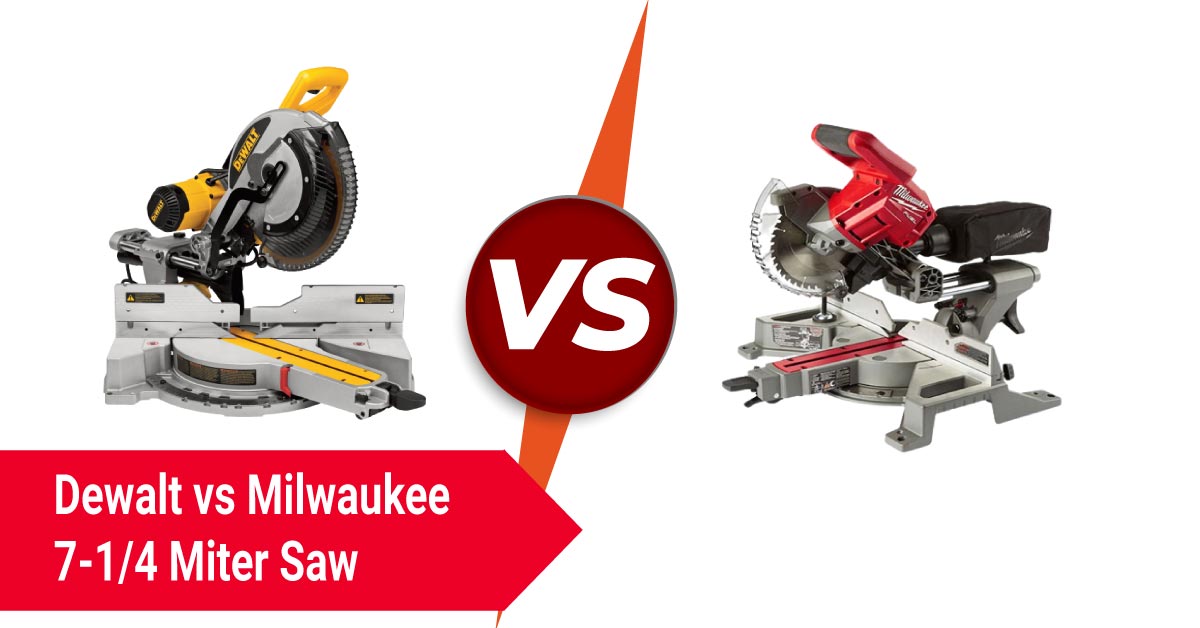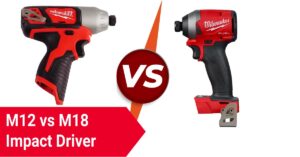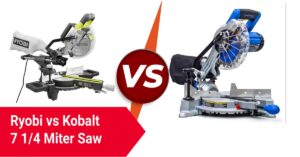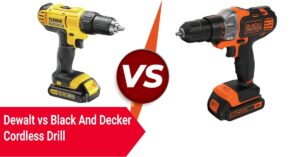The Milwaukee 7 1/4″ miter saw is a great tool for any woodworking project. It comes with all the features you need to get started, including a powerful motor and laser guide for precision cuts, plus a beveled fence that helps you keep an edge on your piece. However, other saws out there offer similar features at a lower price point—and we’ve got them right here in this article!
DeWalt vs Milwaukee 7 1/4 Miter Saw
When shopping for a miter, saw, you want to ensure it’s powerful enough to handle your needs. The power of both saws is roughly equal, but there are some differences between them.
The Milwaukee 7 1/4-Inch 14 Amp Miter Saw has an aluminum base with a laser cuttable bevel and riving knife system. It offers better ergonomics than DeWalt’s tool since it has an adjustable work light that can switch automatically when necessary; this feature makes it easier to see what you’re doing when working in dimly lit areas or at night.
The most important difference between these two tools lies in their motors: Milwaukee uses a premium motor while DeWalt uses a standard motor which means higher costs for replacement parts (and lower overall performance).
However, if durability is more important for your project than cost savings, we recommend choosing either option as they both provide similar results at their respective price points.”
Motor
The motor is the essential part of a miter saw. It drives the blade, determining how fast it spins and how powerful your saw is.
The motor sits in the central hub of your miter saw, behind an aluminum cover plate. It’s usually secured with two phillips screws that you can use to take off this cover plate if necessary (or if you want to access some other part of your saw).
Riving knife and bevel adjustment – how it works
A riving knife is a tool that you use to push material against the blade. It’s also used when making miters and dadoes in woodworking projects, but it can be useful in many other applications too.
The difference between a riving knife and a bevel adjustment is that the latter has two angles–one for each side of a cut (left and right), while the former only has one angle because it’s designed to fit into slots on your miter saw that are made specifically for them. If you’re just starting out with woodworking, it might seem like there is little difference between these two types of attachments–but trust me: there is!
A riving knife lets you do more precise cuts than using just an angle guide would allow; it also gives you better control over how much room there will be between each piece once they’re cut down all around their edge (which means less waste).
You can adjust how thickly material needs to be cut with this tool by changing its angle before cutting begins so as not have too much clearance between planks or lumber pieces themselves when using them on larger projects where multiple boards stacked together could cause problems later down line if done incorrectly due enough time passes without any maintenance being done between work sessions.
Ergonomics
The first thing to consider when you’re choosing a miter saw is how it feels in your hands. You want the saw to be comfortable, so you can work without pain or fatigue over extended periods of time. If this isn’t something that matters to you, then by all means go with Milwaukee–an established name makes it with decades of experience making tools for professionals.
But if ergonomics are important to you, there are two things DeWalt does better than Milwaukee: 1) The handles on its saws are angled at an angle that allows for more comfort when cutting long pieces of wood or metal (especially if they’re irregularly shaped); and 2) The fence makes it easier for users like me who don’t know their left from right from which direction my cuts should be coming from when I’m working on projects with large panels or other components that require careful placement before assembly.
You should opt for the best miter saw on the market
A good miter saw is an investment that you should consider making. The right tool will save you time and help you get the job done efficiently, but choosing one with all the features you need is important. Here are some features to look for when shopping around:
- A laser guide allows you to align your cut lines with ease. This prevents accidents while cutting and helps prevent tear-out or splintering of wood.
- A beveled fence provides accurate alignment across the entire range of cuts, which means less waste and better results in the end!
- A dust collection system keeps your workspace clean so that dust doesn’t get everywhere; this makes it easier for everyone involved–from yourself down through those who work alongside–in case there’s any debris left over after cutting something (or someone).
DeWalt vs Milwaukee 7 1/4 Miter Saw: How They Measure Up
The DeWalt DW717 6-Inch Miter Saw with Laser Guide is a great choice for beginners who want a saw they can be confident in. It’s light, easy to set up and use, and has everything you need to start cutting wood efficiently.
The Milwaukee 6390-20 7-1/4″ Compact Miter Saw is another good choice for beginners because it offers many of the same features as the DeWalt model but also includes some additional tools that make life easier when working on projects around your house or office space (like measuring tape).
DeWalt vs. Milwaukee 7 1/4 Miter Saw: Our Pick
The DeWalt DW7435 is a great choice for most home users, and it’s also the best choice for DIYers looking for a miter saw that can handle many different projects.
The Milwaukee 27.2-volt cordless miter saw has some great features, but it is less durable and versatile than our top pick. In addition to its poor build quality, this saw doesn’t come with an anti-kickback tab system like the DeWalt does–a feature that prevents kickback and injury when cutting through materials such as wood or plastic by keeping your hand away from the blade at all times during use (which could be dangerous if you’re using another tool).
The Milwaukee does have more power than our primary recommendation; however, compared side by side with both models’ 6″ capacity and 13 1/4″ long body lengths (in inches), we found them equally capable of handling tasks like cutting 2x4s in half lengthwise while maintaining accuracy throughout each cut!
DeWalt DW717 6-Inch Miter Saw with Laser Guide
DeWalt’s 717 is a great choice for those who want a high-quality miter saw at an affordable price. The DeWalt DW717 6-Inch Miter Saw with Laser Guide is designed to easily cut wood, metal, and plastic, as well as other materials like PVC pipe and acrylic. With its powerful motor and smooth sliding fence system, it makes quick work of any job in your shop!
The unit comes equipped with an 8″ blade that can be used for cutting wood or metal; however, if you’re looking for something more specialized than that, like cutting sheetrock or marble, we recommend getting one of our top picks instead (see below).
Features to Look Out For
In addition to having a laser guide and beveled fence, the DeWalt is dust-quiet, which is ideal for cutting wood.
The Milwaukee has a dust collection system and anti-kickback tabs (which help protect your fingers), but it’s more quiet than the DeWalt. In fact, we found that this saw was much louder than other miter saws we tested at our shop.
The more expensive DeWalt has a laser guide, which is helpful for accurate cuts, but it also has a beveled fence that helps you keep an edge on your piece. The Milwaukee 7 1/4 Miter Saw doesn’t have these features.
The Milwaukee comes with a durable dust collection system as well as anti-kickback tabs that prevent accidental injury while you work (think fingers or hands get caught in the blade). The DeWalt miter saw has a similar feature but doesn’t have an anti-kickback tab.
The DeWalt features more power, making it ideal for larger projects and furniture making. If you need to cut through heavy wood quickly, this may be what you’re looking for–but keep in mind that if your job requires precision cuts or intricate detail work, then this saw isn’t going to be ideal for your needs.
Both models have similar horsepower; however, they differ slightly in weight: The Milwaukee weighs in at 17 pounds while the DeWalt weighs 15 pounds!
These saws are both excellent choices, so choose based on what you need the most!
The DeWalt DCS3442 is a good choice if you’re looking for a saw with a powerful motor, good tool steel and an accurate blade. The Milwaukee 7 1/4 Miter Saw has all of those things as well, but its ergonomics are less comfortable to use than the DeWalt’s.
Both saws have good warranties and availability of parts; however, if your budget is tight or time is critical–for example, if you’re building an entire house in one day–the Milwaukee may be more affordable overall since it costs less than $200 while others cost over $400 just on their own (or even more than $600).
Conclusion
So, which one should you choose? It is a tough decision. Both saws are great and we think that both companies are committed to making their machines as reliable as possible. We recommend going with whichever one best fits your needs (and budget), but we do stand by our recommendation that you spend more on a good miter saw than you would ever regret.




